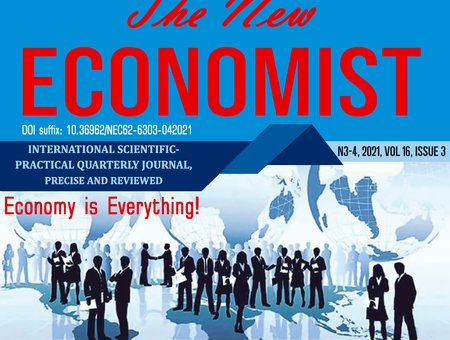Features of the Use of Digital Marketing in the Banking Sector / ციფრული მარკეტინგის გამოყენების თავისებურებები საბანკო სექტორში

Nugzar Todua / ნუგზარ თოდუა
Doctor of Economics Science, Professor and Head of Marketing Department, Tbilisi State University / ეკონომიკის მეცნიერებათა დოქტორი, თსუ ეკონომიკისა და ბიზნესის ფაკულტეტის პროფესორი, მარკეტინგის კათედრის ხელმძღვანელი

Nino Gogitidze / ნინო გოგიტიძე
PhD candidate, Faculty of Economics and Business, Tbilisi State University / თსუ ეკონომიკისა და ბიზნესის ფაკულტეტის დოქტორანტი
Abstract
In the 21st century, the business has become a digital technology-driven system that can hugely impact consumer behavior and labor productivity. The use of the Internet in the new information age is a visible example of globalization. Electronic platforms offer continuous information dissemination, interactive communication with users, and digital systems for conducting transactions in the modern economy. In the context of the digital revolution, along with the changes made to improve services, the electronic transformation of banks has also become necessary, as modern technologies can increase the productivity, permanence, and transparency of the use of information.
The paper identifies the key features of digital marketing that make companies successful in the banking sector. The use of digital channels in the financial industry is growing day by day and, regardless of the level of development of countries, is characterized by a growing trend everywhere. The article analyzes digital banking marketing strategies and opportunities that are indispensable conditions for attracting customers in a changing business environment.
The paper highlights the role of social media in shaping individual messaging in the banking industry and creating a product tailored to the target audience. Based on secondary data analysis, the focus is on the role of mobile marketing in digital banking marketing. It is noted that mobile marketing simplifies the implementation of banking operations for customers.
The article highlights the importance of switching to digital services in the banking industry during the COVID-19 pandemic, indicators of digital channel usage, customer engagement in mobile banking, and forecasts for the future. It has been shown that in the context of the COVID-19 pandemic, the key issue for banks is to identify consumer confidence-building indicators. The paper presents the latest statistics that have reflected on the underlying characteristics of consumer behavior from the beginning of the COVID-19 pandemic to the present day. After analyzing the secondary data, the article found that the active use of smartphones has increased the importance of online advertising, which will continue in the future. With this in mind, the key recommendations that financial companies need to follow to succeed and optimize their budgets are precisely in the direction of popular digital platforms.
One of the most important issues of the paper is the increased consumption of cryptocurrency in the world, which is due to its sharp increase in popularity among users. Based on the above, the article shows that if technology companies expand the use of digital currency, the forms of physical services of banks will become obsolete, and the only way to popularize banking products will remain digital marketing.
Introduction
References
- Ananda, S., Devesh, S., & Al Lawati, A. M. (2020). What factors drive the adoption of digital banking? An empirical study from the perspective of Omani retail banking. Journal of Financial Services Marketing, Vol. 25 No. 1, pp. 14-24.
- Apil, A. R., Kaynak, E., and Todua, N. (2009). Product Preference Differences of High and Low Ethnocentric Consumers in Georgia. In Proceedings of the 18th World Business Congress „Management Challenges in an Environment of Increasing Regional and Global Concerns“,International Management Development Association, pp. 531-539.
- Bačík, R., Fedorko, R., Kakalejčík, L., & Pudło, P. (2015). The importance of Facebook ads in terms of online promotion. Journal of applied economic sciences, Vol. 10 No. 5, pp. 670-677.
- Baicu, C. G., Gârdan, I. P., Gârdan, D. A., & Epuran, G. (2020). The impact of COVID-19 on consumer behavior in retail banking. Evidence from Romania. Management & Marketing: Challenges for the Knowledge Society, Vol. 15, No. S1, pp. 534-556.
- Bhadeshiya, H. B. (2021). Role of Cryptocurrency in Digital Marketing. In Blockchain Technology and Applications for Digital Marketing (pp. 64-83), Hershey: IGI Global.
- Boston Consulting Group (2021). Global Retail Banking 2021: The Front-to-Back Digital Retail Bank. Available from: https://www.bcg.com/publications/2021/global-retail-banking-report (Accessed 16 November 2020).
- Capgemini (2021). World Retail Banking Report 2021: To create new value, banks can adopt Banking-as-a-Service to embed finance in consumer lifestyles. Available from: https://www.capgemini.com/news/world-retail-banking-report-2021-to-create-new-value-banks-can-adopt-banking-as-a-service-to-embed-finance-in-consumer-lifestyles/ (Accessed 16 November 2020).
- CISION (2021). Social Media Advertising Market Is The Second Biggest Market Within Digital Advertising. Available from: https://www.prnewswire.com/news-releases/social-media-advertising-market-is-the-second-biggest-market-within-digital-advertising-301249882.html (Accessed 16 November 2020).
- CNBC (2021). Digital ad spend grew 12% in 2020 despite hit from pandemic. Available from: https://www.cnbc.com/2021/04/07/digital-ad-spend-grew-12percent-in-2020-despite-hit-from-pandemic.html (Accessed 16 November 2020).
- Datareportal (2021). Digital Around the World. Available from: https://datareportal.com/global-digital-overview (Accessed 16 November 2020).
- Dootson, P., Beatson, A., & Drennan, J. (2016). Financial institutions using social media–do consumers perceive value? International Journal of Bank Marketing, Vol. 34 No. 1, pp. 9-36.
- Ernst & Young Global Limited (2021). How COVID-19 has sped up digitization for the banking sector. Available from: https://www.ey.com/en_gl/financial-services-emeia/how-covid-19-has-sped-up-digitization-for-the-banking-sector (Accessed 16 November 2020).
- Hafez, M. (2021). The impact of social media marketing activities on brand equity in the banking sector in Bangladesh: the mediating role of brand love and brand trust. International Journal of Bank Marketing. Vol. 39 No. 7, pp. 1353-1376.
- Hollebeek, L. D., & Macky, K. (2019). Digital content marketing's role in fostering consumer engagement, trust, and value: Framework, fundamental propositions, and implications. Journal of Interactive Marketing, Vol. 45, No. 1, pp. 27-41.
- HubSpot (2021). The Ultimate List of Marketing Statistics for 2021. Available from: https://www.hubspot.com/marketing-statistics (Accessed 16 November 2020).
- Interactive Advertising Bureau (2021). 2020/21 COVID Impact on Advertising. Available from: https://www.iab.com/wp-content/uploads/2020/09/200831.SpendResearchStudyNo6.FINAL_.pdf (Accessed 16 November 2020).
- Kitsios, F., Giatsidis, I., & Kamariotou, M. (2021). Digital Transformation and Strategy in the Banking Sector: Evaluating the Acceptance Rate of E-Services. Journal of Open Innovation: Technology, Market, and Complexity, Vol. 7 No. 3, pp. 1-14.
- Lumpkin, S., & Schich, S. (2020). Banks, Digital Banking Initiatives and the Financial Safety Net: Theory and Analytical Framework. Journal of Economic Science Research, Vol. 3 No. 1, pp. 24-46.
- Mahboub, R. M. (2018). The impact of social media usage on performance of the banking sector in Middle East and North Africa countries. International Journal of Economics and Business Administration, Vol. 6 No. 3, pp. 3-20.
20. Makudza, F. (2020). Augmenting customer loyalty through customer experience management in the banking industry. Journal of Asian Business and Economic studies, Vol. 28 No. 3, pp. 191-203.
21. Marcu, M. R. (2021). The impact of the COVID-19 pandemic on the banking sector. Management Dynamics in the Knowledge Economy, Vol. 9 No. 2, pp. 205-223.
22. Mehta, N., & Shah, S. (2020). Payment Banks: Digital Revolution in Indian Banking System. International Journal of Management and Humanities, Vol. 4 No. 6. pp. 110 - 115.
23. Naeem, M., & Ozuem, W. (2021). The role of social media in internet banking transition during COVID-19 pandemic: Using multiple methods and sources in qualitative research. Journal of Retailing and Consumer Services, Vol. 60 (May), 102483.
24. Nelson, M. R. (1999). Bank marketing and information technology: a historical analysis of the post‐1970 period. International Journal of Bank Marketing, Vol. 17 No. 6, pp. 265-274.
25. Nso, M. A. (2018). The role of e-banking as a marketing tool. Innovative Marketing, Vol. 14 No. 4, pp. 56-65.
26. Obara K. (2021). Media Buying for digital Markeitng. Middlesex University, UK
27. OECD (2020). Digital Disruption in Banking and its Impact on Competition. Available from: https://www.oecd.org/daf/competition/digital-disruption-in-financial-markets.htm (Accessed 16 November 2020).
28. Ogbadu, E. E., & Abdullahi, U. (2013). Fundamental role of marketing in the banking sector. Management Science and Engineering, Vol. 7 No. 2, pp. 64-69.
29. Robul, Y. (2020). Structure and Constituents of Digital Marketing Systems. Olsztyn Economic Journal, Vol. 15 No.1, pp. 53-62.
30. Sawhney, A., & Ahuja, V. (2021). Drivers of Social Media Content Marketing in the Banking Sector: A Literature Review. International Journal of Service Science, Management, Engineering, and Technology, Vol. 12 No. 3, pp. 54-72.
31. Soniya, K., & Santhosh, R. (2018). Digital Marketing in Banking Evolution or revolution. International Journal of Scientific Development and Research, Vol. 3 No. 7, pp. 169-175.
32. Statista (2020). Digital advertising spending worldwide from 2019 to 2024. Available from: https://www.statista.com/statistics/237974/online-advertising-spending-worldwide/ (Accessed 16 November 2020).
33. Statista (2021). Mobile advertising spending worldwide: 2007-2023. Available from: https://www.statista.com/statistics/303817/mobile-internet-advertising-revenue-worldwide/ (Accessed 16 November 2020).
34. Todua, N. (2018). Impact of Social Media Marketing on Consumer Behavior in the Georgian Tourism Industry. International Academy Journal Web of Scholar, Vol. 3 No. 5/23, pp. 11-16.
35. Todua, N. (2019). Using social media marketing for attracting foreign tourists to Georgian destinations. Globalization and Business, Vol. 7, pp. 39-48.
36. Todua, N., & Jashi, Ch. (2013). Challenges of Social Marketing in Georgia. TSU Science, Vol. 5, pp. 59-62.
37. Todua, N., & Jashi, C. (2018). Influence of Social Marketing on the Behavior of Georgian Consumers Regarding Healthy Nutrition. Bulletin of the Georgian National Academy of Sciences, Vol. 12 No. 2, pp. 183-190.
38. Tran, N. A. (2021). Intention to Use Digital Banking Services of Young Retail Customers in Vietnam. The Journal of Asian Finance, Economics and Business, Vol. 8 No. 8, pp. 387-397.
39. Umamaheswari, B., & Kumawat, V. (2021). The Evolution and Growth of Digital Marketing. International Journal of Mobile Computing Devices, Vol. 6 No. 2, pp. 27-30.
40. Urotadze, E. (2020). The role of social media marketing in attitude towards Georgian consumers to travel agencies. In Proceedings of the 7th Business Systems Laboratory International Symposium „Socio-Economic Ecosystems: Challenges for Sustainable Development in the Digital Era“, University of Alicante (Spain), pp. 236-241.
41. Vejačka, M. (2017). Social media marketing in comparison with other forms of marketing in the slovak banking sector. Market/Tržište, Vol. 29 No. 1, pp. 23-38.
42. Vetrivel, S. C., Rajini, J., & Krishnamoorthy, V. (2020). Influence of internet banking service quality on customer satisfaction-An Indian experience. Journal of Critical Reviews, Vol. 7 No.2, pp. 546-551.
43. Yushaeva, R., & Vakhabova, M. (2020). Digital Transformation of the banking System: Digital Technologies and Digital Banking Models. European Proceedings of Social and Behavioural Sciences (EpSBS), Vol. 103, pp. 75-79.
References
The New Economist N3-4, (2021), Vol 16, Issue 3

11/01/2022
Copyright (c) 2022 Nugzar Todua / ნუგზარ თოდუა, Nino Gogitidze / ნინო გოგიტიძე

This work is licensed under a Creative Commons Attribution-NonCommercial-NoDerivatives 4.0 International License.
